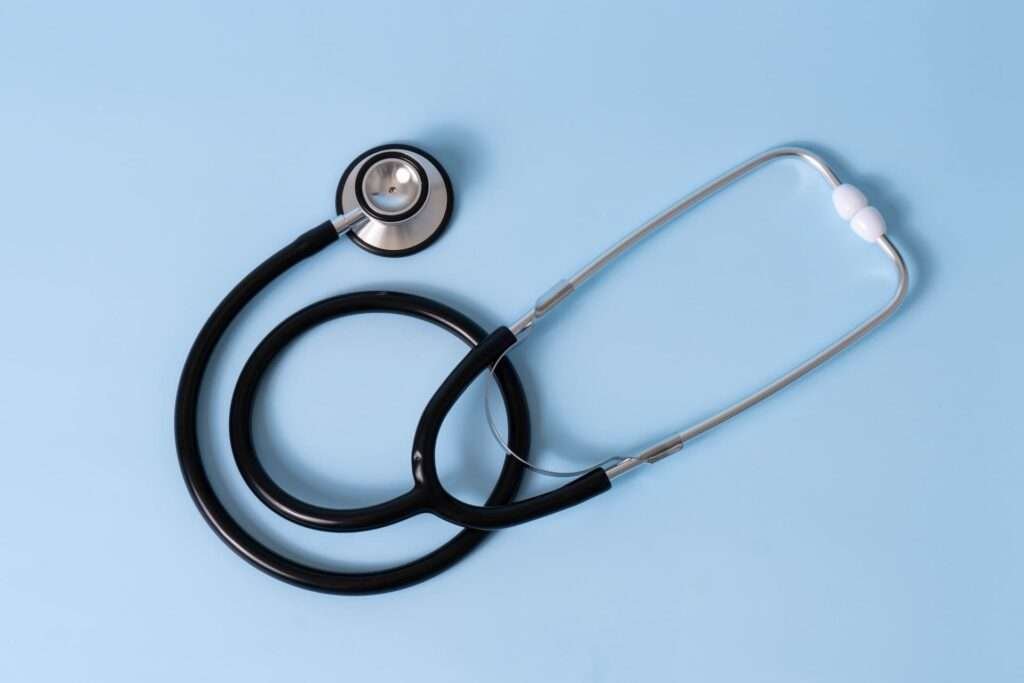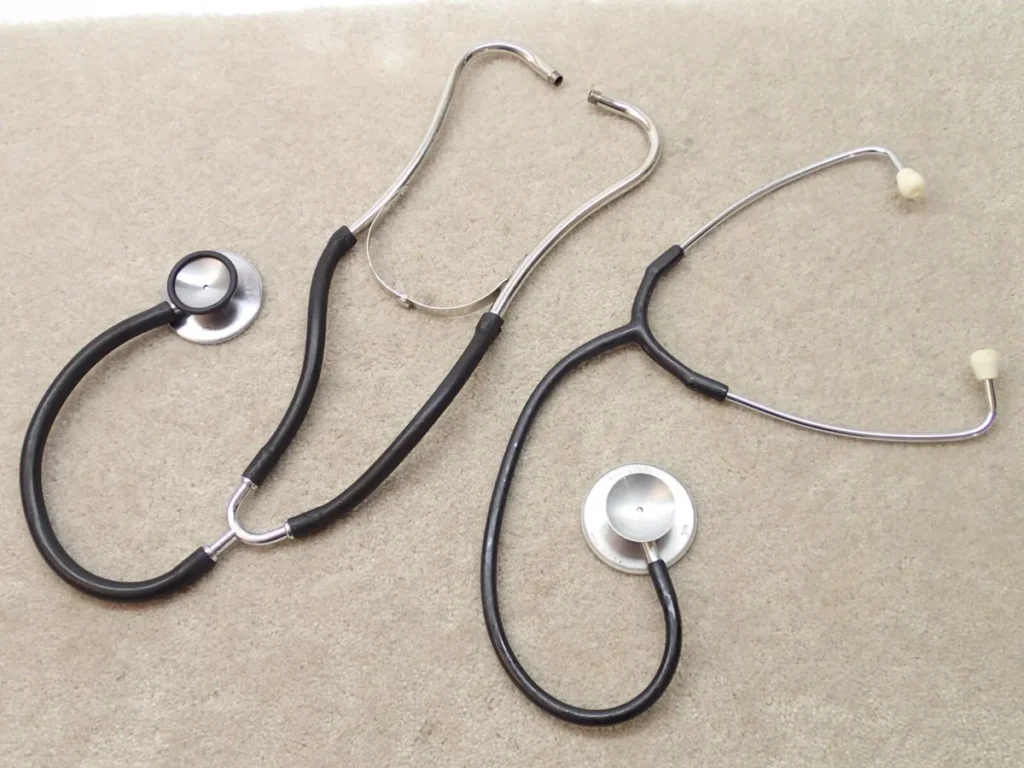
The Evolution of the Stethoscope in Medical Feild is a fundamental medical device healthcare professionals use to listen to sounds within the body, particularly the heart and lungs. It consists of a chest piece, tubing, and earpieces. The stethoscope’s importance lies in its ability to diagnose various medical conditions by detecting abnormal sounds such as murmurs, wheezes, and crackles. It is a primary tool for assessing cardiac, pulmonary, and vascular health, enabling clinicians to make informed decisions about patient care.
The Humble Beginnings (18th Century)

In 1816, French physician Rene Laennec revolutionized medicine with his invention of the stethoscope. Laennec’s groundbreaking creation stemmed from a situation he encountered while examining a female patient. Due to the cultural norms of the time, directly auscultating her chest for heart sounds was deemed inappropriate, leaving Laennec in a challenging position.
Accorrding to nlm,The stethoscope symbolizes the essence of medicine, serving as a visible testament to the years of rigorous education and training doctors undergo to earn their title and practice medicine proficiently. As an iconic and widely used tool, its significance in the medical field is immeasurable. It’s challenging to imagine medicine before the stethoscope, and the accomplishments made without this tool seem miraculous.
In response to this dilemma, Laennec ingeniously devised an alternative method using a simple rolled-up piece of paper. By placing one end against the patient’s chest and his ear against the other, he discovered that the paper could transmit sounds effectively, allowing him to listen to the heart and lungs more discretely.
This initial makeshift instrument laid the foundation for what would later become the stethoscope, marking the beginning of a transformative journey in medical diagnostics.
Evolution and Refinement (19th Century)

Although innovative, Laennec’s initial stethoscope design had limitations. The rolled-up paper tube provided limited sound transmission and lacked durability. However, throughout the 19th century, significant improvements transformed the stethoscope into a more sophisticated diagnostic tool.
One notable advancement was the replacement of paper tubes with cones made of wood or metal. These materials offered better sound transmission and enhanced durability, improving the overall effectiveness of the stethoscope.
Further refinements came with binaural stethoscopes featuring two earpieces credited to Arthur Leared and George P. Cammann. This innovation improved sound clarity and increased comfort for the practitioner, enabling more accurate diagnoses.
Another significant development was the adoption of rubber tubing, which replaced previously used rigid materials. Rubber tubing made the stethoscope more flexible and lightweight, enhancing ease of use and patient comfort during examinations. These evolutionary steps in stethoscope design laid the groundwork for its continued advancement and widespread adoption in medical practice.
The 20th Century and Beyond: The Littmann Stethoscope and Advancements

In the 1960s, Dr. David Littmann, an American cardiologist, made significant contributions to stethoscope design that revolutionized auscultation. Dr. Littmann’s innovations focused on enhancing sound quality and versatility for healthcare practitioners.
The key feature of the Littmann stethoscope was the tunable diaphragm, which allowed clinicians to conveniently switch between high and low frequencies by adjusting the pressure applied to the chest piece. This innovation provided greater diagnostic clarity and efficiency during examinations, enabling healthcare professionals to detect subtle variations in sound more effectively.
Additionally, the Littmann stethoscope incorporated ergonomic design elements for improved comfort and usability, such as soft-sealing ear tips and lightweight materials.
Electronic stethoscopes emerged as a further advancement in auscultation technology in the latter half of the 20th century and beyond. These stethoscopes integrated electronic components for recording, amplifying, and filtering sounds, offering sound visualization, wireless connectivity, and noise cancellation features. While electronic stethoscopes complement traditional models, they provide additional functionalities that enhance diagnostic capabilities, particularly in noisy environments or telemedicine settings.
The Stethoscope’s Enduring Legacy

Beyond its practical utility, the stethoscope holds profound symbolic value in medicine, embodying the timeless connection between healthcare professionals and their patients. Its presence around a physician’s neck is a universal symbol of expertise, trust, and compassionate care. Moreover, the act of auscultation represents a deeply personal interaction, where the physician listens attentively to the body’s inner workings, forging a bond of understanding and empathy with the patient.
While modern medicine boasts an array of sophisticated diagnostic tools, the stethoscope’s simplicity and reliability endure. Its effectiveness in detecting crucial auditory cues, portability, and ease of use make it an indispensable tool in clinical practice. Despite the availability of advanced imaging techniques and electronic devices, the stethoscope remains unparalleled in providing immediate, real-time feedback at the point of care.
Potential future advancements in stethoscope technology may include further integration of digital enhancements, such as artificial intelligence algorithms for automated interpretation of auscultatory findings, or the incorporation of wireless connectivity for seamless data transmission and remote monitoring. However, as technology continues to evolve, the essence of the stethoscope as a timeless symbol of medical expertise and human connection will endure, ensuring its place as an indispensable tool in the physician’s arsenal for future generations.
Foreshadow the Evolution of the Stethoscope

The stethoscope, initially a simple hollow tube, has evolved significantly since its invention in the early 19th century by French physician René Laennec. Here’s a foreshadowing of its evolution:
Early Development (19th Century)
Laennec’s original design consisted of a wooden tube, which he used to listen to sounds within the body. This marked the birth of auscultation, listening to internal sounds.
Improvements in Material and Design (Late 19th to Early 20th Century)
As medicine advanced, so did the stethoscope. Rubber and metal were introduced, making the instrument more durable and enhancing sound transmission. Binaural design (with earpieces for both ears) was also adopted, allowing for stereo listening and better isolation of sounds.
Electronic Stethoscopes (Late 20th Century)
With the advent of electronic technology, electronic stethoscopes emerged. These devices amplified sounds, filtered out ambient noise, and sometimes even allowed for recording and playback of auscultatory findings. This innovation greatly enhanced the accuracy of diagnosis, especially in noisy environments.
Digitization and Connectivity (21st Century)
Stethoscopes became increasingly integrated with digital technology. Digital stethoscopes incorporated Bluetooth connectivity, enabling real-time transmission of auscultatory data to smartphones or computers. This facilitated remote consultations, telemedicine, and collaboration among healthcare professionals.
Advanced Signal Processing and AI Integration (Present and Future)
As artificial intelligence (AI) and machine learning algorithms continue to advance, stethoscopes will likely incorporate these technologies. AI could assist in identifying and interpreting subtle acoustic cues that might indicate underlying pathology, thereby augmenting healthcare providers’ diagnostic capabilities. Additionally, advanced signal processing techniques could further enhance the clarity and accuracy of auscultatory findings.
Miniaturization and Wearable Devices (Future)
The evolution of technology may lead to the development of miniature, wearable stethoscope-like devices. These could continuously monitor physiological parameters, such as heart and lung sounds, in real-time, providing valuable insights into a patient’s health status. Integration with other wearable health monitoring devices could enable comprehensive health tracking and early detection of abnormalities.
The Potential Future Advancements in Stethoscope Technology

Certainly! Here are some potential future advancements in stethoscope technology:
Artificial Intelligence Integration
Stethoscopes could incorporate AI algorithms capable of analyzing auscultatory sounds in real time. These algorithms could assist healthcare providers in detecting subtle abnormalities, differentiating between similar sounds, and providing diagnostic insights based on patterns identified in the data.
Enhanced Signal Processing
Advanced signal processing techniques could further refine the quality of auscultatory signals, reducing noise and enhancing the clarity of relevant sounds. This could improve the accuracy of diagnosis, especially in challenging clinical environments.
Wireless Connectivity and Cloud Integration
Stethoscopes may feature seamless wireless connectivity, allowing instant transmission of auscultatory data to electronic health records (EHRs) or cloud-based platforms. This would enable efficient data management, remote consultations, and collaborative decision-making among healthcare professionals.
Augmented Reality (AR) Visualization
AR technology could overlay visualizations of auscultatory findings onto the user’s field of view in real time. This visual augmentation could aid in interpretation, allowing healthcare providers to correlate sounds with anatomical structures and pathology, enhancing diagnostic accuracy.
Personalized Medicine Features
Future stethoscopes might incorporate personalized medicine features, such as patient-specific sound profiles or algorithms tailored to individual characteristics. This could improve the sensitivity and specificity of diagnosis by accounting for variations in patient demographics, physiology, and pathology.
Multi-Modal Sensing
Stethoscopes could integrate additional sensors, such as accelerometers or electrocardiogram (ECG) electrodes, to capture complementary physiological data alongside auscultatory sounds. Multi-modal sensing would provide a more comprehensive cardiac and respiratory function assessment, facilitating early detection of abnormalities and personalized treatment strategies.
Miniaturization and Wearable Form Factors
Advances in miniaturization could lead to the development of wearable stethoscope-like devices that seamlessly integrate into everyday clothing or accessories. These wearable devices could continuously monitor physiological parameters, offering real-time health insights and proactive disease management.
Smartphone Integration
Stethoscopes may further leverage smartphones’ capabilities, serving as attachments or peripherals that interface with dedicated mobile applications. These applications could provide enhanced visualization tools, diagnostic decision support, and educational resources for healthcare providers.
Conclusion

As the heartbeat of medical innovation continues to pulse, the stethoscope stands as a timeless symbol of progress in healthcare. From its humble beginnings as a simple wooden tube to its current state as a sophisticated diagnostic marvel, the evolution of the stethoscope reflects the tireless dedication of medical pioneers to improve patient care.
As we look toward the future, with advancements in artificial intelligence, wireless connectivity, and personalized medicine on the horizon, the stethoscope remains poised to continue its journey as a trusted companion in the hands of healthcare providers worldwide, listening not just to the sounds of the body, but to the symphony of human health itself.
